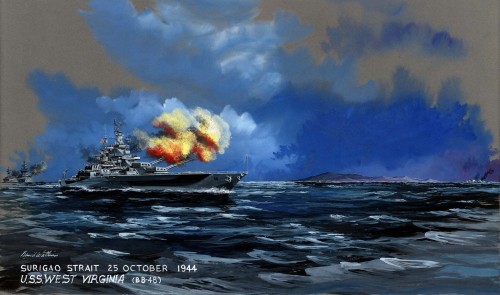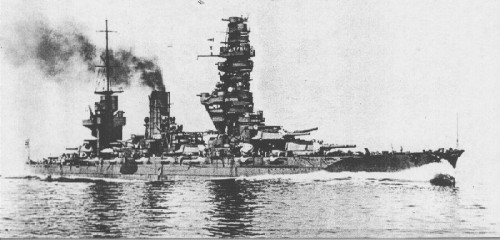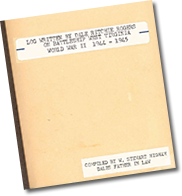Wed. Oct. 25, 1944
Darling Mine:
Shortly after 03 :45 our radar picked up the Jap Task Force, steaming down Surigao Strait. At 03 :53 we fired our first salvo (4-inch salvo) no change – no change, reported. We continued to fire. The Cruisers then opened up with their 8-inch. All guns opened up with all gun salvos. There was so much firing and so many 8-inch, 14-inch, and l6-inch salvos in the air it looked like A.A. machine gun fire.
When we turned from Starboard to Port to fire, Air Defense lookouts saw the salvos for the first time and reported it as A.A. fire.
Explosions occasionally illuminated the horizon. We are hitting something what ever it is.
We headed back to Leyte Gulf, approximately 15 minutes after our first salvo. I wonder what we were hitting. What ever it was it fired back but its aim was very poor.
Air defense at daybreak. Attack repulsed by Air Combat Patrol. Combat Patrol reports shooting down 6 planes. Air defense at sunset, repulsed by Air Combat Patrol.
Here we have a first hand account of what historians count as one of the great naval battles of the second World War. This battle changed the nature of naval warfare due to the technology used. The USS West Virginia had been upgraded with the Mark 8 Fire Control Radar (FCR) during its retrofit. This allowed the USS West Virginia to fire over the horizon. This American technology was vastly superior to anything the Japanese had at the time.
The Japanese were planning on driving the American fleet away from the landing beaches by using a pincer attack. If the American fleet could be drawn away from the landing beaches, the Japanese could have isolated McArthur’s forces, resulting in their annihilation.
The new radar picked up the large naval force coming from the south to attack, and 3 battleships with the new Mark 8 FCR (the West Virginia, California, and Tennessee) were able to start firing at ranges previously unheard of (especially during the night). The Japanese expected to get in close, and have a toe to toe fight, but the American technology stopped the Japanese from afar.
The battle was incredibly one sided. The West Virginia was responsible for much of the damage done to the Japanese navy that night. The West Virginia also supplied much of the rest of the fleet with firing solutions. Many Japanese destroyers, cruisers, and the battleship “Fuso” were destroyed during the action.
The Battle of Surigao Strait was the last time that battleships ever went head to head against each other. It was the end of an era that included Nelson’s ships of the line crossing the T to victory. The sheer size and firepower of the battleships that saw action in Surigao Strait would be replaced by stealth and precision in later eras.
View larger map





